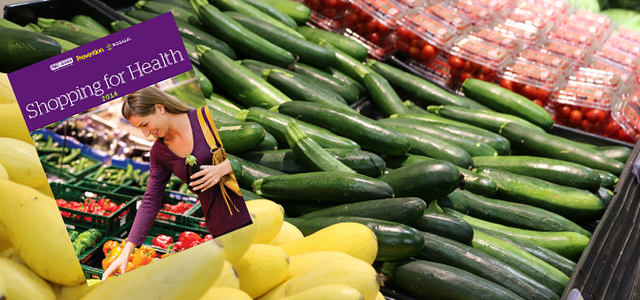
By Cathy Polley, RPh, Vice President, Health & Wellness; Executive Director, FMI Foundation
Today we launched our 22nd annual survey with Prevention that explores consumers’ health and nutrition attitudes and how these beliefs influence the way they grocery shop. Shopping for Health offers valuable shopper insights regarding the growing trend at retail to provide patient-centered care, specifically opportunities for pharmacy, nutrition and merchandising to come together as a support system in the supermarket aisles.
The report demonstrates the shopper connection between food and health, giving insights into how many shoppers are making at least some small changes to their cooking and buying habits, whether trying a new healthy recipe (58 percent), buying more products with whole grains (43 percent), or participating in a variety of other healthy shopping activities. The report details that nearly half of shoppers (44 percent) say they are buying more fresh ingredients now, up from 34 percent two years ago. One-third say they are buying more food based on nutritional components; and 31 percent say they are buying more foods with reduced or no calories/fat/sugar/salt. As a positive trend, 75 percent of shoppers say in the past year they have switched to a healthier version of at least one of the 21 types of food surveyed. Notably, these trends are consistent between men and women and across generational groups.
Anne Alexander, senior vice president and editorial director for Prevention magazine, said, “It’s important to recognize that shoppers said they use multiple strategies to achieve healthy eating, so there are numerous pathways to a common goal. Our research identified the top-three strategies as consuming fewer unhealthy food items (62 percent of respondents), preparing and cooking more healthy dishes (57 percent), and eating out less often (39 percent).”
As a pharmacist by trade, I can comprehend the power behind the convergence of food and wellness in the aisles. Still, Shopping for Health is a yearly reminder to us that our shoppers want incentives and resources in order to be successful when it comes to their health. While FMI continues to benchmark how food retailers offer voluntary labeling programs, cooking classes and demos, in-store and corporate dietitians, pharmacists and more, for customers, motivation is often inherent in the simple recognition that their food retailer has their best interest at heart.
For a copy of the 2014 Shopping for Health survey, visit www.fmi.org/store
Additional resources can be found at www.prevention.com.


 Industry Topics address your specific area of expertise with resources, reports, events and more.
Industry Topics address your specific area of expertise with resources, reports, events and more.
 Our Research covers consumer behavior and retail operation benchmarks so you can make informed business decisions.
Our Research covers consumer behavior and retail operation benchmarks so you can make informed business decisions.
 Events and Education including online and in-person help you advance your food retail career.
Events and Education including online and in-person help you advance your food retail career.
 Food Safety training, resources and guidance that help you create a company food safety culture.
Food Safety training, resources and guidance that help you create a company food safety culture.
 Government Affairs work — federal and state — on the latest food industry policy, regulatory and legislative issues.
Government Affairs work — federal and state — on the latest food industry policy, regulatory and legislative issues.
 Get Involved. From industry awards to newsletters and committees, these resources help you take advantage of your membership.
Get Involved. From industry awards to newsletters and committees, these resources help you take advantage of your membership.
 Best practices, guidance documents, infographics, signage and more for the food industry on the COVID-19 pandemic.
Best practices, guidance documents, infographics, signage and more for the food industry on the COVID-19 pandemic.
